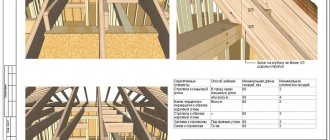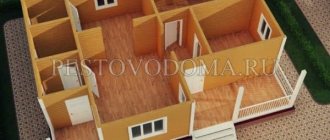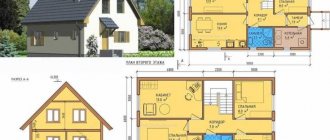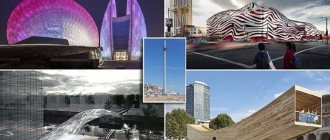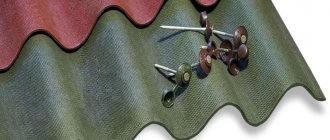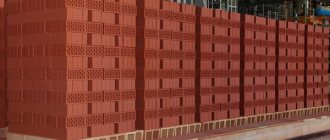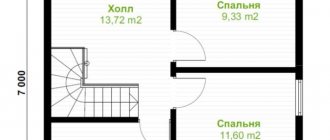Real estate
00:00, 16.12.2020 7 Plot: House in focus
Why hire an architect at all?
Photo: happymodern.ru
Before you begin construction, you must first decide on the design of the house. Depending on who will build your house - a private team or a construction company, you will decide whether the house design will be standard or individual, whether you will order it at all or make do with hand drawings. Market experts still advise not to save on the project and to hire an architect to develop it. Let’s figure out how to choose this valuable specialist and what external signs will help confirm his competence (or incompetence). And the head of the construction company KingDom, Igor Suslov, helps us with this.
Thomas Jefferson's Villa at Monticello (1769–1784)
USA, Virginia, Charlottesville, Thomas Jefferson Parkway, 931
Thomas Jefferson. Painting by Rembrandt Peale. 1800 © Wikimedia Commons
Thomas Jefferson, American aristocrat, diplomat and one-time president Thomas Jefferson , the third president of the United States from 1801 to 1809, was the architect of a building that he spent his life building. This is the manor house on Jefferson's plantation at Monticello. The appearance of the house is traditional, and its technical equipment is revolutionary. There are many engineering discoveries there, some of which will become commonplace only in the next century, and others of which are completely useless: flush toilets, a dumbwaiter, a device that allows you to write on paper while simultaneously creating a copy (something like a photocopier powered by muscles), and hidden in the floor a complex mechanism thanks to which, by pushing one of the door leaves, you open both. In a word, this is some kind of house of a mad scientist. You can just imagine Jefferson torturing James Bond in one of his spacious basements. An architect's home, especially in the 20th century, is an experimental site. Thomas Jefferson's house is the first in this row.
1 / 6
Monticello Estate © Martin Falbisoner / Wikimedia Commons, 2010
2 / 6
Monticello Estate © Darren and Brad / Flickr, 2011
3 / 6
Garden pavilion at the Monticello estate © Mr.TinDC/Flickr, 2008
4 / 6
Dining room at Monticello © Darren and Brad / Flickr, 2011
5 / 6
Monticello Estate © Carol M. Highsmith / Library of Congress, 2015
6 / 6
Monticello Estate © Darren and Brad / Flickr, 2011
Eames House
Year of construction: 1945—1949 Place: Los Angeles, California, USA Materials: glass, steel, concrete, aluminum, wood
The home of designer couple Charles and Ray Eames in the suburbs of Los Angeles was designed as part of a program to build experimental housing. The architects who participated in this program used the latest materials and technologies developed during World War II in their projects. The houses had to demonstrate a modern style and be simple to build. The Eameses' house, originally built as a competition showpiece, later became their own.
The building sits on a hillside and is supported by a massive concrete retaining wall. The building itself consists of two glass rectangular blocks, one of which houses a studio-workshop, and the other - living quarters. The steel frames are filled with rectangular inserts of various colors and sizes - panels made of glass, aluminum and asbestos. The Eames house seems like a living embodiment of the abstract paintings of Piet Mondrian.
The interior is replete with assorted furniture made from natural materials and numerous decorative items. There is no clear division of space. The abundance of wood, soft diffused light penetrating through multi-colored panels, and some creative randomness - all this creates a special, very personal atmosphere.
John Soane House (1792–1824)
UK, London, Lincoln's Inn Fields, 12, 13, 14
John Soane. Painting by Thomas Lawrence. 1828–1829 © Wikimedia Commons
John Soane is the most unclassical of the classicist architects, and his house is the strangest of his works. The architect gradually expanded it, buying neighboring properties, rebuilding them and building up courtyards. The result was a confusing and cramped labyrinth with rooms of different sizes and shapes, invisible doors in the corners, “wells” connecting the floors, and streams of light pouring from invisible cracks above, from the sides, and sometimes, it seems, even from below. Soane, like any enlightened English nobleman of that era, collected antiques and paintings and added more and more rooms to the house so that there was room to house the ever-growing collection. Exhibits cover the walls of the tiny halls so thickly that it is difficult to walk around the house without brushing your ear or nose against some Roman marble.
1 / 7
John Soane House Museum © Ewan Munro / Flickr, 2008
2 / 7
John Soane House Museum © Wikimedia Commons, 1983
3 / 7
John Soane House Museum © stu smith / Flickr, 1980
4 / 7
John Soane House Museum © stu smith / Flickr, 1980
5 / 7
John Soane House Museum © stu smith / Flickr, 1980
6 / 7
John Soane House Museum © Kotomi/Flickr, 2008
7 / 7
John Soane House Museum © stu smith / Flickr, 1980
Log house with sauna 90 m² made of dead pine
Number of views >21300
Location: Finland Area: 90 m² Floors: 1st floor Type of house: log Photo: Hawkhill Nature
The country house Villa Maria was built from kelo pine. The one-story building has a rectangular plan, its area is 90 m². Construction from dead wood had many advantages in comparison with logs of natural moisture: warping of the crowns was practically minimal, the material did not change color, and the appearance of mold and microorganisms was obviously excluded.
Note that Finnish cutting technology provides excellent protection from moisture and wind. During Russian felling, the longitudinal groove remains open. Finnish craftsmen make the groove closed: its peculiarity is that it has a more concave shape, so that the insulation is completely hidden. Therefore, during operation, a Finnish house does not require caulking.
As for the bowl, it has a trapezoidal shape. The tenon ensures ideal mating of the crowns, and during the shrinkage process the joints are sealed.
7
House of Victor Horta (1898–1901)
Belgium, Brussels, Rue American, 25
Victor Horta. 1900 © Wikimedia Commons
Victor Horta invented Art Nouveau architecture. Before Orta, furniture, lamps and tabletop figurines were made in the Art Nouveau style (aka Art Nouveau style) - and it never occurred to anyone that an entire house could be built in the same style. Therefore, the four mansions that Horta built in Brussels, including his own house, are considered important landmarks of the city, museumized and carefully preserved with all their furnishings. All Art Nouveau architects built mansions for themselves (and Fyodor Shekhtel had two), but only the Orta mansion completely preserved its original furnishings. And in Art Nouveau houses, the furnishings are the most valuable thing. Their furniture, doors, fittings - in a word, all interior details were created in a single copy, as integral parts of this building only.
1 / 8
Victor Horta House Museum © Francisco Antunes / Flickr, 2010
2 / 8
Victor Horta House Museum © María Ouro / Flickr, 2007
3 / 8
Victor Orta House Museum © Xavier Ashe / Flickr, 2011
4 / 8
Victor Orta House Museum © Wikimedia Commons, 2011
5 / 8
House-Museum of Victor Orth © mksfca/Flickr, 1997
6 / 8
Victor Orta House Museum © Xavier Ashe / Flickr, 2011
7 / 8
House-Museum of Victor Horta © tsoleau/Flickr, 2008
8 / 8
House-Museum of Victor Orth © bookchen/Flickr, 2008
Cheap house 30 m² with sauna, built by two students on a wetland
Number of views > 48300
Location: USA Authors of the project:
studio politaire
Area: 30 m² Floors: 1 floor House type: frame Photo: André Boettcher
Architecture students Timm Bergmann and Jonas Becker decided to test themselves and design a house. They built the house together, only occasionally resorting to the help of friends. The budget was limited to 12,000 euros.
The frame of the house was installed on a foundation of galvanized water pipes that a local contractor welded together. Mostly natural materials were used for construction. So, the box was assembled from locally produced lumber and multi-layer plywood.
In order to stay within the tight budget and test the technology, the students did almost all the work themselves.
There were no communications on the site; currently the house is not even connected to electricity. The heat is provided by a metal wood-burning stove, as well as a stove in the sauna. A dry toilet was installed in the yard.
4
Rudolf Schindler's house (1921–1922)
USA, California, West Hollywood, North Kings Road, 833
Rudolf Michael Schindler © ncmodernist.org
From a modern point of view, this is not a house, but a hostel. There are no bedrooms, living room or dining room, but several rooms, each intended for one person, and one common utility room. Its design is also unusual: instead of a foundation there is a flat slab of concrete floor, some walls are made of layered concrete, like a Napoleon cake, and others are glass, lattice and sliding, like in traditional Japanese architecture. Schindler was famous during his lifetime, but not famous. His buildings were too experimental to appeal to the general public. But our contemporaries, Californian deconstructionist architects, consider Schindler their predecessor, idolize him and endlessly discuss how to preserve his house.
1 / 5
Rudolf Schindler's House © Chris Mottalini / ncmodernist.org
2 / 5
Rudolf Schindler's House © Julius Shulman / Wikimedia Commons, 1997
3 / 5
Rudolf Schindler's House © Allan Ferguson / Wikimedia Commons, 2001
4 / 5
Rudolf Schindler's House © Allan Ferguson / Wikimedia Commons, 2001
5 / 5
Rudolf Schindler's House © Allan Ferguson / Wikimedia Commons, 2001
"Cabanon" by Le Corbusier
Years built: 1951—1952 Place: Roquebrune-Cap-Martin, France Materials: wood, plywood
Not a house, but rather a hut - the last refuge of the great modernist on the Cote d'Azur of France, where he spent the last years of his life. The small space of 15 m², slightly smaller than a ship's cabin, is an example of an architect's minimal home. Although the appearance of the cabin resembles a traditional log structure, it is carefully designed using a modular system developed by Le Corbusier based on the proportions of the human body.
“Not a single square centimeter was wasted. A small cell in the kingdom of human existence in which every accident was foreseen."
The house, made from prefabricated parts and defiantly modest materials, has everything you need: a workspace, a sitting area, storage cabinets, plumbing and a primitive ventilation system. The walls are decorated with colorful murals and the ceiling is coated with a layer of paint. Built next to a restaurant, the house did not need a kitchen: the door led directly to the dining room.
The only building designed by Le Corbusier exclusively for himself can hardly be called a soulless “machine for living.” Despite the apparent contradiction of some of the principles of the modernist, the hut is ample proof that strict adherence to proportions and attention to light are the keys to perfection in architecture.
Schröder House by Gerrit Rietveld (1924)
The Netherlands, Utrecht, Prins-Hendriklan, 50
Gerrit Thomas Rietveld. 1962 © Wikimedia Commons
Gerrit Rietveld, the leading Dutch modernist architect, built this house for the widow Truce Schröder and her three children, but during the construction process he became so friendly with the customer that he moved into the house with her and lived there all his life. It is believed that in this project Rietveld transferred the principles of abstract painting by Piet Mondrian into three-dimensional space. Even more than the paintings of Mondrian, the building is similar to the works of Russian Suprematists: the architects of Malevich, the prouns of Lissitzky. What it is not at all like is “normal” modernist houses: there is too much color, too many details that are not determined by function. Nevertheless, he is their predecessor. The Schröder House is one of the early bold experiments on which the architecture of modernism emerged.
1 / 5
House Schroeder © Wikimedia Commons, 2011
2 / 5
House Schröder © Hay Kranen / Wikimedia Commons, 2010
3 / 5
House Schroeder © Erik Honig / Wikimedia Commons, 2011
4 / 5
House Schroeder © Wikimedia Commons, 2010
5 / 5
House Schroeder © Wikimedia Commons, 2010
How to behave in negotiations with an architect?
Your architect is the person you trust to design your dream home. You will be investing a lot of money not only in the project, but also in the design and materials, and you need to be sure that you can get closer to your ideal.
When you are interviewing various architects for a job, one of the deciding factors should be whether you deliver and whether you are confident enough that you can approach them and everything will work fine.
A breakdown in communication can have a lasting impact on the entire project, so when choosing an architect, make sure you can depend on them and that you are comfortable with them.
House of Konstantin Melnikov (1927–1929)
Moscow, Krivoarbatsky lane, 10
Konstantin Melnikov © Wikimedia Commons
All architects of the 20th century built houses for themselves. All except the Soviet ones. In the USSR it was not customary to build mansions. How Melnikov managed this is a mystery. We are lucky that it was he, the greatest visionary among the architects of the Soviet avant-garde, who succeeded. His house turned out to be unlike anything else, made of two cylinders, with walls like a honeycomb and one bedroom for all family members. This mansion is an architectural masterpiece, known all over the world, and for foreign tourists it is one of the most important attractions in Moscow. But for us Russians, it is important not as an architectural masterpiece, but as a cultural anomaly. A mansion built during the era of the damned “housing question”, with a proud inscription “Konstantin Melnikov architect” above the entrance and a huge and bright, like a temple, workshop on the third floor is a manifestation of the dignity of the profession, which no one recognized for it in the USSR, where architects were anonymous functionaries of design institutes and slaves of the Construction Complex.
1 / 12
Melnikov House © Nikolai Vassiliev / Flickr, 2015
2 / 12
Melnikov House © Viktoria Savuta / Wikimedia Commons, 2014
3 / 12
Melnikov House © Viktoria Savuta / Wikimedia Commons, 2014
4 / 12
Melnikov House © Alex Naanou / Flickr, 2014
5 / 12
Melnikov House © Viktoria Savuta / Wikimedia Commons, 2014
6 / 12
Melnikov House © Viktoria Savuta / Wikimedia Commons, 2014
7 / 12
Melnikov House © Alex Naanou / Flickr, 2014
8 / 12
Melnikov House © Alex Naanou / Flickr, 2014
9 / 12
One of the children's rooms in Melnikov's house © Alex Naanou / Flickr, 2014
10 / 12
Melnikov House © Nikolai Vassiliev / Flickr, 2013
11 / 12
Bedroom in Melnikov's house. 1920s © Wikimedia Commons
12 / 12
Frame of a house under construction. At the house - Konstantin Melnikov and his wife. 1927 © Wikimedia Commons
House Schröder in Utrecht
Years built: 1923—1924 Place: Utrecht, Netherlands Materials: reinforced concrete, steel, brick, wood
Gerrit Rietveld, the most famous Dutch architect and designer of the 20th century, at the request of his widow and later his actual wife, Truce Schröder, designed a house in Utrecht. The recently widowed mother of three wanted a home that perfectly matched her idea of an ideal home. She dreamed of a space that would not limit her.
The house was designed in accordance with the principles of neo-plasticism and the Dutch art association "De Stijl", of which Rietveld was a member. Characteristic features of this direction: the desire for universality, strict geometry of forms, artistic purity and rigor. The house looks like an orderly system of black, gray, white, blue, red and yellow elements. The building does not serve as a background for an abstract composition, but is itself one.
The frame of the house is made of reinforced concrete slabs and steel profiles, the walls are made of brick. The first floor has a completely traditional layout - the kitchen, studio and library are separated by walls. The second floor is a space that can be easily transformed using sliding panels. Instead of curtains, colored plywood shutters were used. According to the principles of neoplasticism, interior items were painted in the colors of the main palette. All the furniture in the house was made by Gerrit Rietveld himself.
Frank Lloyd Wright's Taliesin Estate (1911–1959)
USA, Wisconsin, Spring Green, County Road, 5481
Frank Lloyd Wright. Photo by Al Ravenna. 1954 © Library of Congress
Taliesin is the largest of all architects' houses, the architect's house with the most terrible history, and the only architect's house where you can get a degree in architecture. This is the estate that Wright inherited from his mother and lived in for most of his life. His architectural bureau was located there, and since 1932, Wright’s private architectural school, which still operates today. Thanks to this university, Wright became the second most influential architect of the 20th century after Le Corbusier. If Le Corbusier is the father of modernist architecture, then Wright is the grandfather of postmodernism. He hated modernist architecture and fought against it as best he could. Wright's many architect students in the 1960s and 1970s carried his struggle to a victorious conclusion. Wright's most terrible memories are associated with the estate. It burned down completely twice: first in 1914, when a servant gone mad killed Wright's mistress and her children and set their bodies on fire, and in 1925, just after Wright built it a second time. The site is now occupied by several buildings that Wright gradually erected since 1928.
1 / 8
Taliesin Estate © Marc Heiden / Wikimedia Commons, 2012
2 / 8
Taliesin Estate © Wikimedia Commons, 2012
3 / 8
Taliesin Estate © Michael D Martin / Flickr, 2011
4 / 8
Estate "Taliesin" © sswj/Flickr, 2012
5 / 8
Taliesin Estate © Inga Munsinger Cotton / Flickr, 2005
6 / 8
Taliesin Estate © Inga Munsinger Cotton / Flickr, 2005
7 / 8
Estate "Taliesin" © sswj/Flickr, 2012
8 / 8
Estate "Taliesin" © sswj/Flickr, 2012
Canoa House by Oscar Niemeyer
Year of construction: 1951—1953 Place: Rio de Janeiro, Brazil Materials: reinforced concrete, glass, wood
Oscar Niemeyer, the last classic of modernism and student of Le Corbusier, was the complete opposite of his teacher. Le Corbusier's architecture was based on functionality, ergonomics and technology. Niemeyer's architecture is poetic, sensual, soft. Inspired by Brazilian nature and the curves of the female figure, he softened the severity of the forms with the expression of a flexible line. Niemeyer was the first to show that concrete could be as malleable and plastic as clay.
The architect's own home overlooking the ocean is a classic example of organic architecture and a manifesto of lyrical modernism. The use of materials such as reinforced concrete and glass, plastic forms, a close connection with nature - all these principles together complement each other, creating an individual style in which the whole essence of Oscar Niemeyer's architecture is concentrated.
“Architecture should be functional, but above all beautiful and harmonious”
The curved flat roof, supported by thin steel columns, and transparent glass walls make the building one with its surroundings. The granite block, part of which is located outside and part of which rises in the living room, actually becomes the center of the entire composition. Niemeyer emphasizes that all barriers and boundaries with the outside world are conditional.
The layout of the house also confirms the architect’s break with conventions. Niemeyer skillfully plays with the concepts of “privacy” and “openness.” On the fully glazed ground floor there is a living room and a kitchen. From the top floor, a staircase leads to a closed area where there are bedrooms, bathrooms and the architect's office. Just a small protected shelter in the endless world of nature beyond human control.
Walter Gropius House (1938)
USA, Massachusetts, Lincoln, Baker Bridge Road, 68
Walter Gropius. Photograph by Hans G. Conrad. 1955 © Wikimedia Commons
Walter Gropius is one of the main architects of modernism, and his move to the United States in the 1930s is a historical event. Since then, not Europe, but America has become the place where the most advanced architecture in the world is created. In America, Gropius taught at the Harvard School of Design, and he used his house as a teaching tool, showing students through his example what modern architecture is: plans and facades as a reflection of the spatial structure, a clear division of functional zones, attention to natural lighting, etc. The house became a symbol of the new International Style architecture that came to America from the Old World, and in doing so attracted criticism from a variety of people - from Frank Lloyd Wright to angry neighbors.
1 / 5
House of Walter Gropius. No earlier than 1939 © Library of Congress
2 / 5
House of Walter Gropius. No earlier than 1939 © Library of Congress
3 / 5
House of Walter Gropius. No earlier than 1939 © Library of Congress
4 / 5
House of Walter Gropius. No earlier than 1939 © Library of Congress
5 / 5
House of Walter Gropius. One of the bedrooms is on the second floor. No earlier than 1939 © Library of Congress
Why is it better to entrust the development of a house project to architects?
Home design experts will help bring your design ideas from imagination to drawing board; they will be able to create a design that suits you and consider any possible obstacles. Their knowledge and experience can inform the design - after all, what they design will be the place you call home - so choosing the right architect for you is perhaps one of the most important decisions you will make.
Before you decide to contact architects, you need to have some background information. The architect will want to know what you need so they can determine if they are interested in taking on the project.
You don't need to have a list of everything you want installed in your future home, but this idea is useful for at least guiding your architect in the right direction:
- number of bedrooms;
- number of bathrooms;
- architectural styles that you like;
- materials you prefer;
- Are you for or against an open plan?
Ernő Goldfinger's House (1939)
UK, London, Willow Road, 1, 2, 3
Ernő Goldfinger © open.edu
This house, like any house that a modernist architect built for himself, is experimental, with many useful finds in the interior. For example, there are no baseboards in the house. The transition from floor to walls is smooth and dust does not accumulate there. Of course, there were built-in wardrobes, sliding walls and differences in floor level. But something else is more important. England is a conservative country where any innovations are viewed with suspicion. The British were frightened by modernist houses, white, with huge windows and chrome parapets. They wondered: is it possible to be modern, but without these extremes? Goldfinger showed that it is possible. His home is a rare example of modernist architecture that respects the context and history of the site. The house has brick facades the same color as other buildings on the same street, and, more importantly, it is traditional in its interior design. This is a typical English terraced house, divided into three isolated parts. That is, in fact, these are three houses with common walls, separate entrances from the street and three gardens behind. Goldfinger lived in the central part and rented out the other two to tenants.
1 / 3
Erno Goldfinger House © Matthew Byrne / Flickr, 2008
2 / 3
Ernő Goldfinger House © Kit Reynolds / Flickr, 2006
3 / 3
Ernő Goldfinger House © Cle0patra/Flickr, 2010
Isn't it better to save on the project and not hire an architect?
It is no secret that many future homeowners do not want to order a separate project and hire an architect - it is a shame to spend money on this. After all, formally drawing up an architectural design for a house is now not required by law.
However, in such considerations of economy there may be a fundamental mistake: a well-designed house design will provide approximately 98% of the material consumption of the house. The architect and designer will outline most of the details: what brand of lintels will be, what floor slabs will be, how much materials will be needed - for example, the cubic capacity of brick or the number of tons of cement. Thus, after working with a professional and competent architect, there will be no excess building materials left on the site, because the specialist operates with clear numbers.
Igor Suslov says:
— Have you perhaps noticed in areas where construction has just been completed, mountains of boards, stacks of bricks, bags of cement? On Avito, sometimes you also come across advertisements in the spirit of “I will sell leftover materials from construction.” At the same time, you need to understand that excess materials mean extra money spent by the customer. In our experience, the average loss of materials from construction using “homemade projects” is 150-200 thousand rubles. At the same time, the average cost of a house project starts from 400 rubles per square meter. That is, even if you pay 40,000 rubles for the project of a 100-meter house, you will save about 100 thousand on the calculation of materials.
So how do savings come about with proper design? This happens because the architect proceeds from the modularity of materials: standard width and height of bricks, volume of gas or foam concrete blocks, standard sizes of floor slabs or standard length of wooden beams. In a word, each material has its own geometric standards, so you need to design your house and premises in such a way that you need to change these standards (for example, saw them off) as little as possible. Proper calculation ensures that a minimum of residues are formed, and therefore money will be saved. The entire list of materials that will need to be used for construction will be attached by the designers to the project.
Proper calculation ensures that a minimum of residues are formed, and therefore money will be saved. Photo: au.ru
Igor Suslov gives an example:
— Lately we have seen a lot of projects in which there are many monolithic floor sections. But such plots are an expensive pleasure. And we see that the architect makes a non-standard calculation, which will have to be implemented at the expense of the customer’s wallet. But all this can be calculated taking into account the standard sizes of the material, because each of them has its own modularity.
Gunnar Asplund's House (1940)
Sweden, Surunda, Hestnesvegen, 55
Erik Gunnar Asplund © Wikimedia Commons
The owner of this small house, Gunnar Asplund, is a famous Swedish architect. It is impossible to guess this by looking at his house. The building looks not like a celebrity villa, but like a peasant’s house in the Swedish countryside. The inside, at first glance, is also nothing special. Nevertheless, this is a masterpiece, it’s just done so finely that the strokes are almost invisible. You need to try very hard to see the details that turn everyday life into poetry (for example, the steps of a staircase that go straight into the mouth of an open fireplace).
1 / 5
Gunnar Asplund's house. Photo by Yokio Yoshimura © erikgunnarasplund.com
2 / 5
Gunnar Asplund's house. Photo by Yokio Yoshimura © erikgunnarasplund.com
3 / 5
Gunnar Asplund's house. Photo by Yokio Yoshimura © erikgunnarasplund.com
4 / 5
Gunnar Asplund's house. Photo by Yokio Yoshimura © erikgunnarasplund.com
5 / 5
House of Gunnar Asplund © sika-design.com
The Glass House by Philip Johnson (1949)
USA, Connecticut, New Canaan, Ponus Ridge Road, 798-856
Philip Johnson. Photo by Benjamin Pietro Filardo © Wikimedia Commons
Philip Johnson organized the International Style exhibition in New York in 1932, which introduced America to European modernist architecture, and then employed the main characters of his exhibition in the United States. Johnson then graduated as an architect, and the first thing he built was his own house. In this small building, like no other, all the principles of modernism were embodied. This is a living capsule of the minimum required area and with a minimum set of furniture, without external walls (all its walls are windows) and without internal partitions (the entire interior is one room), half-dissolved in the greenery and air of the forest, an almost intangible house-idea.
1 / 4
Philip Johnson House © Edelteil / Wikimedia Commons, 2013
2 / 4
Philip Johnson House © Edelteil / Wikimedia Commons, 2011
3 / 4
Philip Johnson House © Edelteil / Wikimedia Commons, 2013
4 / 4
Philip Johnson House © Edelteil / Wikimedia Commons, 2012
Vanna Venturi House
Years built: 1962—1964 Place: Philadelphia, Pennsylvania, USA Materials: brick, wood
In the 60s of the twentieth century, aspiring architect Robert Venturi designs the first “anti-modernist” building in history for his mother. Two years after completion, Venturi published a manifesto, “Complexity and Contradiction in Architecture,” in which he criticized modernism and the International Style. Soon this work would mark the beginning of the postmodern movement, despite the fact that Venturi himself never considered himself a postmodernist.
Behind the external simplicity of the façade lies a complex and contradictory architectural concept. Instead of the already familiar asymmetry, there is almost complete symmetry, broken only by the location of the windows. A gable roof, a pediment “split” into two parts, and a massive chimney, atypical for the architecture of that time - each detail is a kind of protest against modernism. From the outside it may seem that the house is much larger than it actually is - Venturi deliberately distorts the scale.
Violations of proportions are also present in the interior of the house. The size of the fireplace does not correspond to the size of the room, and wide, low doors and windows of different sizes further enhance this visual effect. At the request of the architect's mother, all main living spaces are located on the ground floor. The entire second floor with a spacious studio bedroom and a terrace was occupied by Robert Venturi himself.
Venturi shows that the desire for a polysemantic architecture, with all its attendant contradictions, does not mean a renunciation of functionality and integrity. To Ludwig Mies van der Rohe’s famous phrase “Less is more,” Venturi wittily replies: “If less, then sadder.”
Alvar Aalto's summer house (1952–1953)
Finland, Lake Päijänne, Muuratsalo Island
Alvar Aalto. 1960 © Wikimedia Commons
Finland is a country with a short architectural history. And if the French are proud of their Gothic, the Italians of their Baroque, the Russians of their Empire style, then the Finns are proud of their 20th century architecture. Everything built by Alvar Aalto, the greatest Finnish architect of the last century, is now considered a national treasure and is carefully preserved in its original form. Aalto's summer house, built deep in the Finnish wilderness, on an island accessible only by boat in the 1950s, is a rare example of patriotic modernist architecture. Everything here is filled with thoughts of homeland. Even the boat that stands in the boathouse Boathouse (Dutch helling) a structure for building or repairing ships is called Nemo propheta in patria “There is no prophet in his own country” (Latin).. The house on Muuratsalo was a platform for architectural experiments. On the interior surfaces of the walls surrounding the courtyard, Aalto explored the decorative possibilities of facing bricks, laying them this way and that - in a total of 50 different ways. He planned other experiments: to try to build without a foundation, from bricks of arbitrary shape, and so on, but he carried out only one of them - the guest house really does not have a foundation.
1 / 6
Alvar Aalto House © Jonathan Rieke / Flickr, 2012
2 / 6
Alvar Aalto House © Andrew Carr / Flickr, 2006
3 / 6
Alvar Aalto House © trevor.patt/Flickr, 2011
4 / 6
Alvar Aalto House © Jonathan Rieke / Flickr, 2012
5 / 6
Alvar Aalto House © Jonathan Rieke / Flickr, 2012
6 / 6
Alvar Aalto House © Jonathan Rieke / Flickr, 2012
Albert Frey House (1963–1964)
USA, California, Palm Springs, West Palisades Drive, 686
Albert Frey. Photo by Don Buckner © American Institute of Architects
20th-century architects loved making large windows. They said that thanks to them, nature enters the interior. Here she physically enters the interior. The rock, as if tearing apart the fragile shell of the house, tumbles into the room. This is the most dramatic opposition of natural and artificial principles that the history of architecture knows. But it misleads us. Before building the house, Albert Frey spent a whole year observing how the sun illuminated the site, at what angle the shadows lay, and based on these observations he calculated the position, plan and height of the house. The building was built with such attention to the natural environment that it is more correct to consider it part of the landscape, and not an alien detail in it.
1 / 4
Albert Frey House © Linda_Bisset/Flickr, 2007
2 / 4
Albert Frey's house. Photo by Dan Chevkin © American Institute of Architects
3 / 4
Albert Frey's house. Photo by Dan Chevkin © American Institute of Architects
4 / 4
Albert Frey's house. Photo by Dan Chevkin © American Institute of Architects
Why do we also need a designer and an engineer?
Design work does not end with calculating materials and drawing up a detailed house plan. If the architect has the competence of a designer, he is also a constructive part of the project. But it’s better if these are two separate specialists - after all, these are different types of work.
The structural part of the project is everything related to the construction of the house: masonry plan, layout of slabs, design of the foundation, development of joints, fastening schemes, floor spans. Ideally, an architect develops a house project, after which a designer is involved in the work, who calculates and draws all the technical aspects of the project, calculates the load distribution, and determines the thickness of the load-bearing walls. It is the designer who designs the foundation - based on the calculations that the architect makes when removing the loads. When constructing a house according to the project, all types of loads on all load-bearing structures of the house must be taken into account and correctly distributed.
And finally, the third specialist who can be included in the “ideal” scheme is an engineer who, based on the documentation developed by his two colleagues, supervises the construction and accompanies the project. His functions are not to supervise the workers so that they do not drink and create incidents, but to consistently monitor their work, issue tasks and accept their completion.
Our expert explains:
“The person thinks: “I’ll draw it myself, and let the team build it.” And this can affect durability. The more we invest in a house at the construction stage, the less we will have to invest later during the operation stage. And the costs of the project are not as high as it seems. According to minimal calculations, the costs of the project, design development and supervision are about 2% of the cost of building a house. And there will be more reliability. In addition, architects and designers provide a guarantee for their projects - the market average guarantee is 5 years, but there are also companies that increase this period to 10.
We are talking about geological surveys on the site, which determine the type of soil, possibly the occurrence of groundwater, and the location of geological layers. Photo: spbgeo.ru
Richard Rodgers House (1968–1969)
UK, London, Wimbledon, Parkside, 22
Richard George Rogers © inspirationist.net
Richard Rogers is a high-tech pioneer, and the house he built for his parents in 1968, and then lived in for a long time, is an early example of high-tech architecture. In concept, it is similar to Johnson's Glass House: glass walls (though not all), a single interior space, not divided into rooms. But it's done differently. For example, its walls are made of the same panels as the walls of refrigerators, which allows you to save on heating. This house is the prototype for later and larger-scale buildings by Richard Rogers, such as the Center Georges Pompidou in Paris. The house was listed as a listed building in 2013 and Rogers sold it that same year.
1 / 4
Richard Rodgers House © Of Houses / Flickr, 2015
2 / 4
Richard Rodgers House © Of Houses / Flickr, 2015
3 / 4
Richard Rodgers House © Of Houses / Flickr, 2015
4 / 4
Richard Rodgers House © Of Houses / Flickr, 2015
Jörn Utson House (1971–1973)
Spain, Mallorca, Porto Petro, Carrer de Sa Mitha Yuna, 77
Jorn Utzon. Photo by Ole Hopt. 2000 © Wikimedia Commons
Until the 1960s, architects tried to build as modern as possible. Or even the way they think they should build in the future. And in the 1960s and 1970s, some architects, on the contrary, tried to build houses that seemed to exist outside of history. Such as they could have been built a thousand years later, or a thousand years ago. One such attempt is the house of architect Jorn Utson in Mallorca. It is simple, like a natural formation. Not a drop of concrete, no interior decoration. Only bare stonework, sun and silent poetry of proportions.
1 / 6
Jorn Utson's house © christian skovgaard / Flickr, 2010
2 / 6
Jorn Utson's house © Frans Drewniak / Flickr, 2003
3 / 6
Jorn Utson's house © christian skovgaard / Flickr, 2010
4 / 6
Jorn Utson's house © christian skovgaard / Flickr, 2010
5 / 6
Jorn Utson's house © christian skovgaard / Flickr, 2010
6 / 6
Jorn Utson's house © christian skovgaard / Flickr, 2010
